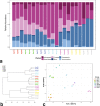Longitudinal 16S rRNA data derived from limb regenerative tissue samples of axolotl Ambystoma mexicanum
- PMID: 31123261
- PMCID: PMC6533342
- DOI: 10.1038/s41597-019-0077-7
Longitudinal 16S rRNA data derived from limb regenerative tissue samples of axolotl Ambystoma mexicanum
Abstract
The Mexican axolotl (Ambystoma mexicanum) is a critically endangered species and a fruitful amphibian model for regenerative biology. Despite growing body of research on the cellular and molecular biology of axolotl limb regeneration, microbiological aspects of this process remain poorly understood. Here, we describe bacterial 16S rRNA amplicon dataset derived from axolotl limb tissue samples in the course of limb regeneration. The raw data was obtained by sequencing V3-V4 region of 16S rRNA gene and comprised 14,569,756 paired-end raw reads generated from 21 samples. Initial data analysis using DADA2 pipeline resulted in amplicon sequence variant (ASV) table containing a total of ca. 5.9 million chimera-removed, high-quality reads and a median of 296,971 reads per sample. The data constitute a useful resource for the research on the microbiological aspects of axolotl limb regeneration and will also broadly facilitate comparative studies in the developmental and conservation biology of this critically endangered species.
Conflict of interest statement
The authors declare no competing interests.
Figures


Similar articles
-
Temporal microbiome changes in axolotl limb regeneration: Stage-specific restructuring of bacterial and fungal communities with a Flavobacterium bloom during blastema proliferation.Wound Repair Regen. 2024 Nov-Dec;32(6):826-839. doi: 10.1111/wrr.13207. Epub 2024 Aug 6. Wound Repair Regen. 2024. PMID: 39105277 Free PMC article.
-
Experimentally induced metamorphosis in highly regenerative axolotl (ambystoma mexicanum) under constant diet restructures microbiota.Sci Rep. 2018 Jul 20;8(1):10974. doi: 10.1038/s41598-018-29373-y. Sci Rep. 2018. PMID: 30030457 Free PMC article.
-
Conservation analysis of core cell cycle regulators and their transcriptional behavior during limb regeneration in Ambystoma mexicanum.Mech Dev. 2020 Dec;164:103651. doi: 10.1016/j.mod.2020.103651. Epub 2020 Oct 28. Mech Dev. 2020. PMID: 33127453
-
Genomics and epigenomics of axolotl regeneration.Int J Dev Biol. 2021;65(7-8-9):465-474. doi: 10.1387/ijdb.200276cs. Int J Dev Biol. 2021. PMID: 33629732 Review.
-
Exploring the role of microRNAs in axolotl regeneration.J Cell Physiol. 2021 Feb;236(2):839-850. doi: 10.1002/jcp.29920. Epub 2020 Jul 7. J Cell Physiol. 2021. PMID: 32638401 Review.
Cited by
-
Proteome data to explore the axolotl limb regeneration capacity at neotenic and metamorphic stages.Data Brief. 2020 Jan 28;29:105179. doi: 10.1016/j.dib.2020.105179. eCollection 2020 Apr. Data Brief. 2020. PMID: 32055664 Free PMC article.
-
Temporal microbiome changes in axolotl limb regeneration: Stage-specific restructuring of bacterial and fungal communities with a Flavobacterium bloom during blastema proliferation.Wound Repair Regen. 2024 Nov-Dec;32(6):826-839. doi: 10.1111/wrr.13207. Epub 2024 Aug 6. Wound Repair Regen. 2024. PMID: 39105277 Free PMC article.
-
The Role of the Microbiota in Regeneration-Associated Processes.Front Cell Dev Biol. 2022 Jan 26;9:768783. doi: 10.3389/fcell.2021.768783. eCollection 2021. Front Cell Dev Biol. 2022. PMID: 35155442 Free PMC article. Review.
-
Investigating Neotenic and Metamorphic Axolotl Brain Complexity: A Stereological and Immunohistochemical Perspective.J Comp Neurol. 2025 Mar;533(3):e70031. doi: 10.1002/cne.70031. J Comp Neurol. 2025. PMID: 40109227 Free PMC article.
References
-
- Zambrano, L. et al. Ambystoma mexicanum. The IUCN Red List of Threatened Species 2010: e.T1095A3229615.10.2305/IUCN.UK.2010-2.RLTS.T1095A3229615.en (2010).
-
- Carlson, B. M. Principles of regenerative biology. (Elsevier, 2011).
-
- Richter W. Regenerative processes following removal of the caudal sector of the telencephalon including the telencephalo-diencephalic border region in Ambystoma mexicanum. Journal fur Hirnforschung. 1968;10:515. - PubMed
Publication types
MeSH terms
Substances
LinkOut - more resources
Full Text Sources

